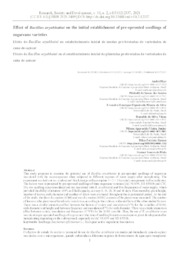Effect of Bacillus aryabhattai on the initial establishment of pre-sprouted seedlings of sugarcane varieties.
Effect of Bacillus aryabhattai on the initial establishment of pre-sprouted seedlings of sugarcane varieties.
Autoria: MAY, A.; SANTOS, M. S. dos; SILVA, E. H. F. M. da; VIANA, R. S.; VIEIRA JUNIOR, N. A.; RAMOS, N. P.; MELO, I. S. de
Resumo: Abstract: This study proposes to examine the potential use of Bacillus aryabhattai in pre-sprouted seedlings of sugarcane inoculated with the microorganism when subjected to different regimes of water supply after transplanting. The experiment was laid out in a randomized-block design with a complete 3 × 2 × 5 factorial arrangement, in five replicates. The factors were represented by pre-sprouted seedlings of three sugarcane varieties (IAC 911099, RB 855156 and CTC 20), two seedling types (inoculated and not inoculated with B. aryabhattai) and five frequencies of water supply, which provided the ability of return to 100% soil field capacity, at every 0, 10, 20, 30 and 40 days. Plant mortality, plant height, number of leaves, stalk diameter and number of tillers were evaluated throughout the experimental period. At the end of the study, the shoot dry matter (SDM) and root dry matter (RDM) contents of the plants were measured. The number of leaves on the plant was affected only in isolation, according to the cultivar, without effects of the other studied factors. There was a double interaction effect between the factors of variety and inoculation (V*I) for the variables of SDM, stalk diameter and height; and between frequency and inoculation (F*I) for stalk diameter. There was a triple interaction effect between variety, inoculation and frequency (V*I*F) for the RDM variable. Thus, the use of B. aryabhattai as an inoculant in pre-sprouted seedlings of sugarcane at the time of seedling formation can improve plant development after transplanting depending on the cultivar used, especially in IAC 911099 and RB 855156.
Ano de publicação: 2021
Tipo de publicação: Artigo de periódico
Unidade: Embrapa Meio Ambiente
Conteúdo relacionado
Observações
1 - Por padrão são exibidas publicações dos últimos 20 anos. Para encontrar publicações mais antigas, configure o filtro ano de publicação, colocando o ano a partir do qual você deseja encontrar publicações. O filtro está na coluna da esquerda na busca acima.
2 - Para ler algumas publicações da Embrapa (apenas as que estão em formato ePub), é necessário ter, no celular ou computador, um desses softwares gratuitos. Sistemas Android: Google Play Livros; IOS: iBooks; Windows e Linux: software Calibre.
Acesse outras publicações
Acesse a Base de Dados da Pesquisa Agropecuária (BDPA) para consultar o acervo completo das bibliotecas da Embrapa.

